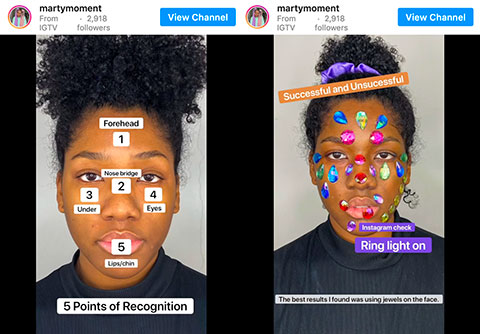
Much work has been done in countering facial recognition technology. Tactics have emerged to trick surveillance and face detection systems by donning “anti-face” or exploiting expectations of the algorithms as well as their built-in bias.
In 2010, Adam Harvey developed Computer Vision Dazzle or CV Dazzle. CV Dazzle can be applied to any computer vision algorithm. There is not a single CV Dazzle design, but rather different options suited for different people against different algorithms. The name of this tactic was inspired by Dazzle, a type of WWI naval camouflage, which implemented cubist-inspired designs to conceal the orientation, shape, and size of a battleship by breaking apart its visual continuity. When donned on the face, CV Dazzle prevents facial recognition algorithms from accessing the biometric profile.
Harvey provides style tips for preventing face detection. However, he warns that this advice was posted in 2010 and it may not be as relevant for deep convoluational neural networks used today.
Martayla Poellinitz created an Instagram post that shows her process of creating her own personalized CV dazzle, consisting of jewels and diagonal strips of black paint on her face.
Harvey has also worked on a counter-surveillance fashion line called Stealth Wear. The fashion wear explores the aesthetics of privacy and the potential for fashion to challenge surveillance systems such as drones. He draws his inspiration from traditional Islamic dress. The items in his line are fabricated with silver-plated fabric that reflects thermal radiation, averting overhead thermal surveillance.
In November 2019, a team composed of researchers at Northeastern University and MIT’s IBM Watson Lab proposed a new type of T-shirt with “adversarial” printed images that would enable people to dodger people-detecting surveillance detectors.
An article put out by Wired Magazine UK divides the techniques for eluding facial recognition systems between two categories: occlusion or confusion. Occlusion works by physically hiding facial features so the algorithms can’t detect them. Occlusion may include donning different features instead of your own. For instance, URME Surveillance, a company dedicated to shielding people from facial recognition technology, has created and mass-produced 3D-printed models of the founder’s face, including his hair and skin texture. Confusion is a technique that makes the facial recognition system think it isn’t looking at a face. Many CV Dazzle designs are examples of confusion, as they confuse computer vision systems by playing with light and dark space in a way that makes a face not detectable by a computer.